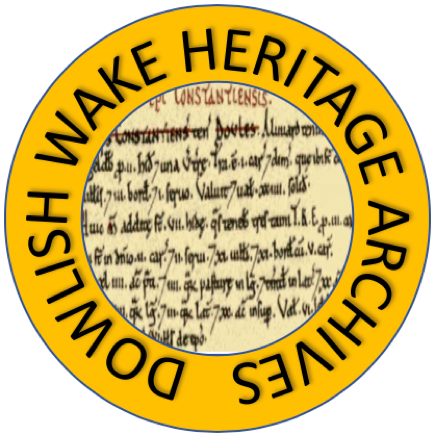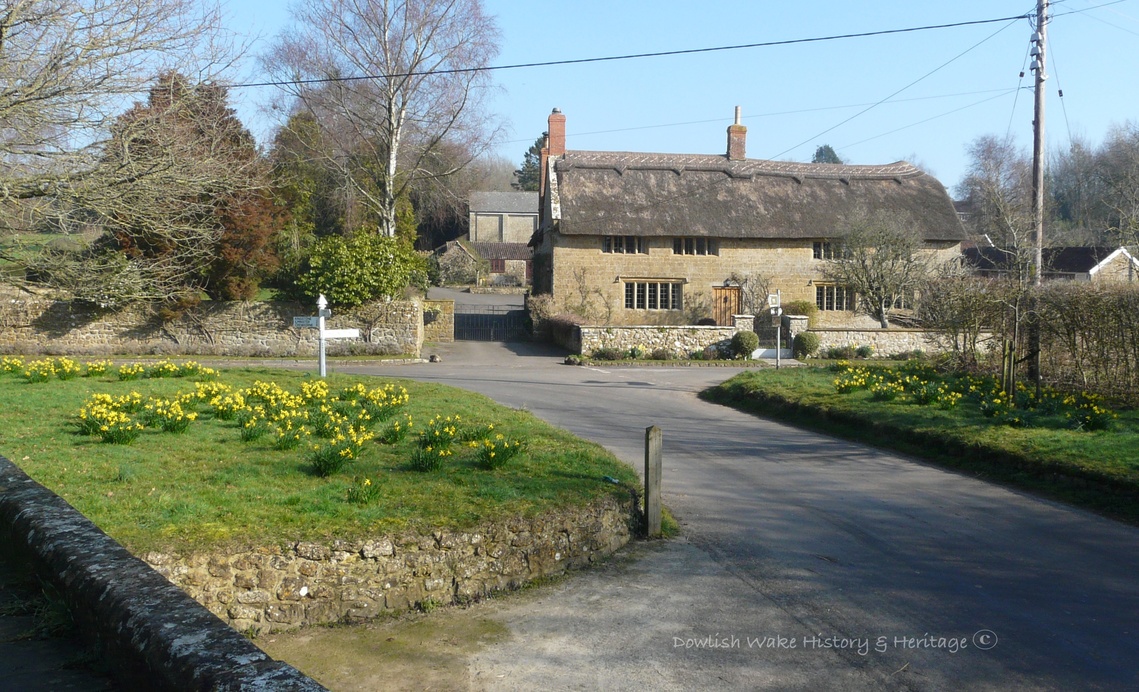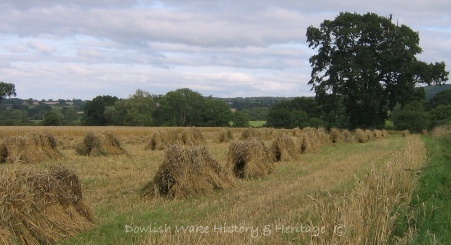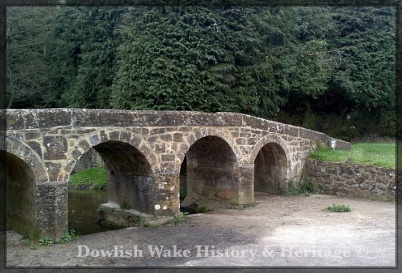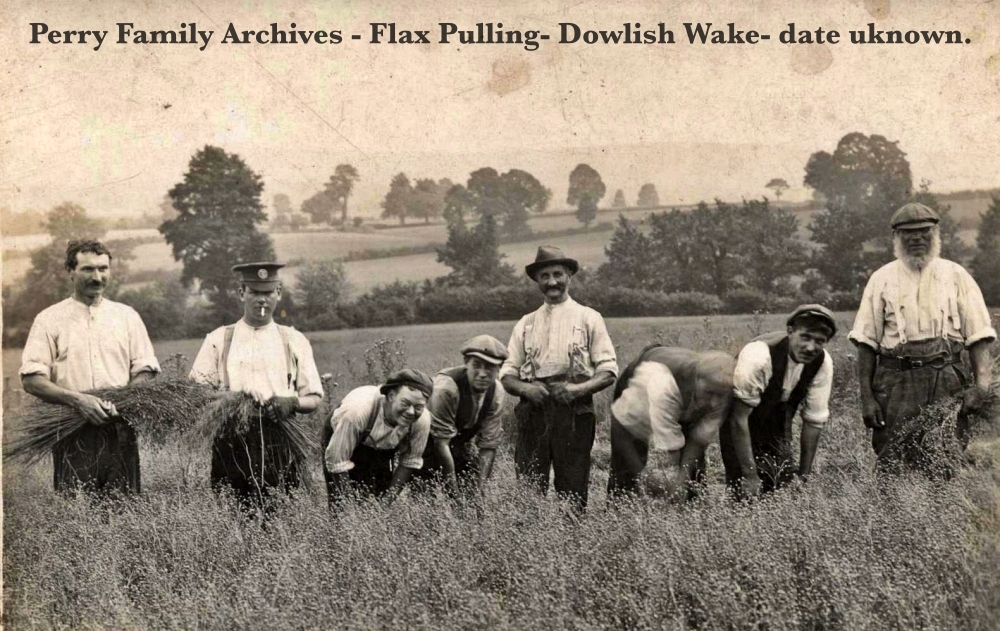
- Here are the lives of folk, both gentry and labourers, the parson, the farmer and the various happenings of these people.
- The manor house, the cottage, the farms, churches, schools and inns, all playing their part. Plus photographs, helping to recreate a vanished way of life.
Dowlish, before the Norman Conquest of 1066, so it is written in the Domesday records, was held by Alward. The Domesday Book of 1086 was a land survey commissioned by William The Conqueror, for the purpose of raising Taxes. It records Dowlish Wake as 'Doules' and having 31 Households, 14 Villagers, 14 smallholders, 3 slaves, and there are 4 beasts, 7 swine and 32 sheep! The land made up of meadow, pasture, and woodland. The many holders of the estate [parish/manor] through time include: Alward, a Saxon Lord, King William is recorded as giving it to The Bishop of Coutances 1086 [Geoffrey de Mowbray- Tenant in Chief advisor to William the Conqueror]. William Montacute, Earl of Salisbury, held it. Then at various times was held by members of the Wake family, with it later being transferred through marriage to a John Speke. The dispersal sale in 1920 of the Dowlish Manor Estate [Major W H Speke, Lord of the Manor and major landowner] brought ownership changes. These sale details/descriptions allowing useful insight into the individual lots/properties.
Nowadays Dowlish Wake is a fairly compact village of around 80 properties, lying some 2 miles South East of Ilminster in South Somerset. The present boundaries of the parish include Oxenford, Moolham, and parts of Kingstone.
It might be argued that present-day Dowlish Wake, sitting in its agricultural setting with fine views to the higher ground of Kingstone and Windwhistle, has remained relatively unchanged over the years. However, the scene is missing many activities and folk. Such as the working watermill in Mill Lane, the lack of folk taking bread to be baked at the mill; Or others fetching water from the standpipes located at various parts of the village. Missing are the echoes of the farmers/builder labourers/field workers with their horse drawn carts. Cattle being driven past cottage windows to the milking parlour of one of the farms. No sheep driven annually to the Sheep Dip. No children attending either of the village schoolrooms. No conversations as folk stopped as they went about their daily activities. On route to maybe the Butcher, Shop-van or the General Shop [annexe to Myrtle Cottage], or the Post Office, the Blacksmith, Carpenter, and Wheelwright.
Free time for the menfolk would have seen the tending of their pig in his pigsty. Or he could be found on his allotment evenings and weekend, having been encouraged to become members of The Labourers Friend Society Club. Potatoes, fruit and vegetables being grown on the small pockets of land donated to village men by Speke. All done to promote good habits and keep them out of mischief. That is, after a long day spent in the fields as well as many a time, a long walk to reach their work! But no doubt the vegetables they grew, would have been a
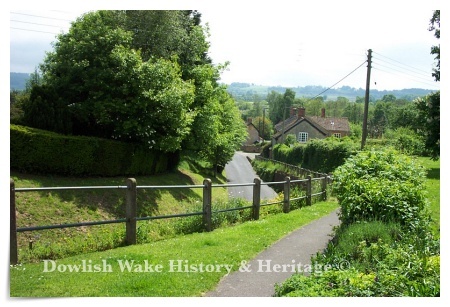
There was a reading room used also for recreation pursuits [Church Path]. This had been provided for the male field workers/labourers, perhaps to entice them from the three inns.
Records suggest three inns, but certainly one at Kingstone, The Castle Inn and in Dowlish the New Inn [previously called the Three Horseshoes]. Inns often used as a venue for a visiting Coroner for inquests. In the past, justice was very much in the public eye. With execution activities suggested by the field name Gallows Down [plot 156 Pretwood Resevoir1838 tithe records] just above Moolham Lane. Then there’s the mystery of Mary Hunt’s grave at Oxenford, [Suicide and Execution dead buried at crossroads].
There were Annual events to attend: The yearly procession of the Dowlish Wake Friendly Society on club day. Farmworkers parading with their many club poles/staves, the brass emblem-top well-polished, marching around the village to the tunes of the Village Band. Calling at every farm where cider refreshments were supplied. The parade, ending at the New Inn where all enjoyed a sit-down meal. This was followed by an afternoon of entertainment, merriment and for those still on their feet, dancing!
A late summer event was competing, with other villages, for prizes at the district exhibition of their best vegetables. In the wintertime the yearly meeting of the Labourers Friend Club held at a local hotel. Ilminster/Crewkerne or Chard. The purpose to distribute the prizes. Refreshments and many speeches given by the gentry.
Whit Monday and Tuesday [4 days in the 1400s] was the fair at Whitedown on Windwhistle Ridge [1361-1850s]. Locally, we see in our lanes, many hollow-ways. Caused no doubt by the many folk attending the fair. Including, stall-holders, carriers/pack-horses and various livestock. Hooves and mud, creating these hollow-ways as they attended from local counties, even, as far away as Wales. On show would have been all manner of goods, stock, and provisions.
Other interests were available, Amateur Dramatic Society, the Village Band. Women had their Women's Institute [1919-2005] At other times, perhaps, sat on their doorstep with lace or glove sewing. Or collar making for the nearby factory at Dowlish Ford.
Yesteryear fields would have seen the blue hue of the Flax crop. Part of Higher Farmhouse has being used as a Flax factory for the production of Dowlas Linen. At Moolham a field name of Silk Factory Yard suggests that industry. There was certainly a hive of industry with glove making in individual cottages. In the fields, way back, teams of oxen ploughing, clues in the field names of Ox Barton, Oxenlease and the hamlet Oxenford.
There have been many interesting and intriguing characters in Dowlish Wake, each leaving a paper trail of insights into their lives; From the lesser-known Perry the Conjurer of 1840 or a Herbal Doctress in 1851 to well-known Capt John Hanning Speke the great explorer. There is the Klondike explorer Ludwig Petterson. The blacksmith and
Records to explore are many and varied such as Dowlish Wakes Church history, St Andrews with its registers dating from about the 1630s, and a list of rectors dated from 1313. The alternative worship of followers of Joanna Southcott. Then there are the military/war records, the economic differences of the social classes, the Workhouse, life expectancy and the Industrial Revolution impact to investigate.
In our time Dowlish Wake still has its thatched hamstone cottages. The pretty setting of the Packhorse Bridge together with the roadside brook. Amongst the attributes are the warm yellow stone of the cottages being built from the Hamstone quarried at nearby Moolham. A small alley-way winds its way through cottages. There’s a cider mill with tea rooms and museum. There’s an inn; The New Inn. Golf Croquet and other clubs. Visiting football teams. Activities enjoyed by many, what’s not to like.
The village, undoubtedly, is providing a diverse wealth of topics to explore for the keen researcher/historian/archivist. So, let’s go headlong and tease out all this rich history, searching the many archives, fleshing out the bare bones with human stories. Hence by exploring, sharing and recording the history of this village, preserve its fine heritage.
